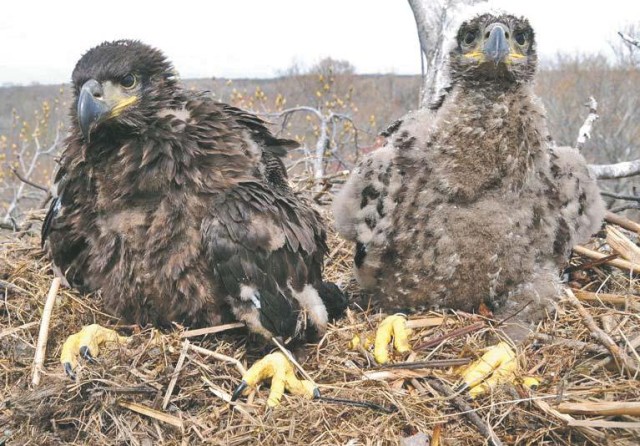ABERDEEN PROVING GROUND, Md. - A young Aberdeen Proving Ground eagle recently found itself blown out of its nest after a violent storm and was rescued and placed with a "foster family."
It all started the morning of April 5, when a fast-moving line of thunderstorms pounded the area with heavy rains and high winds.
Joe Ondek, a biologist with the U.S. Army Aberdeen Test Center who has been monitoring and caring for APG wildlife since 1965, said he had misgivings as the storm blew through.
"I knew that tree, and I knew when that storm went through that tree had to be rocking," said
Ondek, adding that the roots of the tree have been under water for years.
Ondek gathered gear he knew would come in handy in case the tree was downed and headed out. Sure enough, when he reached the area, the top onethird of the tree was gone and the nest
was nowhere in sight.
Ondek said he didn't have to look far, however. Two adult eagles circling overhead pointed him in the right direction and he found the chick in the water nearby.
He approached the chick, speaking softly to calm it and picked it up, taking care to avoid its sharp talons, wrapped it in dry towels and placed it in a coolerlike container with a lid on it.
"Being in the dark and warmth calms them down," said Ondek.
After securing the chick, Ondek contacted Lynda Hartzell, of the Directorate of Public Works Environmental Division, Eagle Compliance Branch; Directorate of Emergency Services game wardens; garrison wildlife biologist John Paul and the garrison environmentalists Amy Burgess and Jessica Baylor.
"I told them we got a bird blown out of its nest and they all came running," Ondek said.
The chick was judged to be about 5 and a half weeks old and about four weeks away from taking its first flight.
Since it could not be returned to its original home, Craig Koppie, a U.S. Fish and Wildlife Service raptor biologist with the Chesapeake Bay Field Office, suggested placing it in a surrogate home
with a similarly aged chick in hopes that the adults would accept it. He and Baylor went on a hastily-arranged aerial search for an appropriate nest and narrowed it down to two.
It was Koppie who scaled the tree to place the bird in the surrogate nest. Using climbing gear similar to that used by linemen to climb telephone poles, Koppie reached the perch. At about 70
feet in the air, he was able to climb over the side and sit on the edge of the nest which measured about 6 feet in width and 4 feet in depth.
The nest contained one female chick; the adults were in sight, circling overhead. Koppie said the chick in the nest watched him warily but didn't seem too disturbed. Nor was the fallen chick once
he was hauled up from the ground in a duffle bag and placed in the nest.
"It was kind of comical," Koppie said. "This bird was actually quite calm, but then he had been handled by humans for the past 24 hours. He looked over my shoulder at the female chick and then looked at me as if to say, 'Who's that'' They were both very timid but they got along fine."
He said he judged the male to be about 10 days older than his new "sibling." Both were tagged with aluminum FWS migratory bird bands for subsequent monitoring. Daily observations have found that the adult pair accepted the chick and are feeding it regularly.
"Human intervention was successful," he said. "It was a very happy ending."
Koppie has been climbing eagle nest trees since 1977 and has coordinated eagle monitoring and safety efforts with APG environmentalists since 2000. He said he is "very impressed" with the priority garrison commanders have placed on the installation's eagle population.
"All the garrison commanders have understood how important this is," he said. "They realize that while they have men and women to train, they also have eagles to manage. I can't speak highly
enough about the APG environmentalists and their operations.
Ondek said he considered Koppie a hero along with the rest of the installation environmental managers.
"We don't always just allow nature to take its course. Human intervention is sometimes necessary," he said, noting that when he came to APG in 1965 there was only one nest on post. "Every time this happens I choke up knowing that this is another one of ours we are taking
care of."
Hartzell said the Eagle Compliance Branch has about 80 nests it tracks each year. She credited DPW, DES, the U.S. Fish and Wildlife Service and U.S. Army Aberdeen Test Center with providing the level of human intervention needed to aid the fallen chick. The entire incident lasted 29 hours.
She also credited the Tri-State Bird Rescue which X-rayed the chick, took blood samples, and "gave it a little quiet time," while keeping it overnight.
"They really are top notch," Hartzell said. "This is an example of how environmental stewardship is an integral part of APG's military mission and shows that it is possible for a protected species and an active military mission to coexist."


Social Sharing